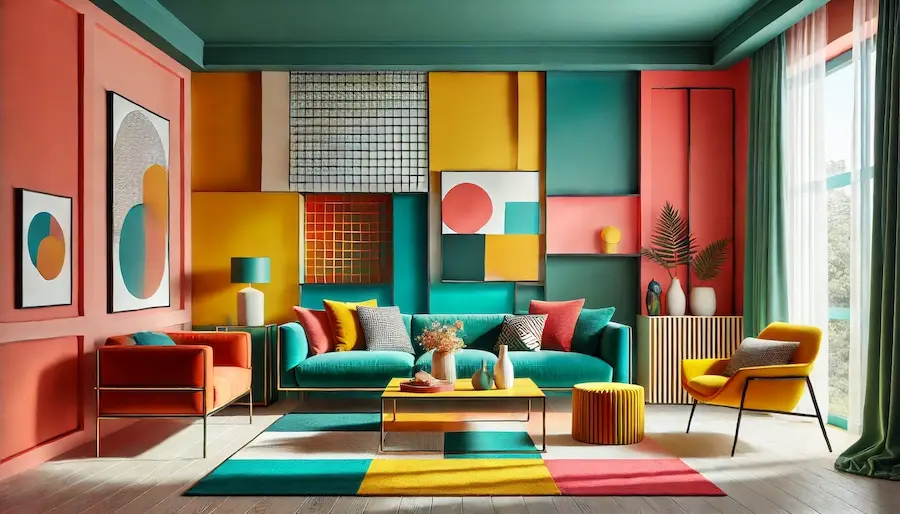Designing a color-blocked living room involves the strategic use of contrasting solid colors to create a dynamic and visually engaging space. This design technique adds depth, character, and a modern flair to your living area.
History and Origins of Color Blocking in Interior Design
Color blocking originated in the art world, notably through the works of Dutch painter Piet Mondrian, who utilized geometric blocks of color to create abstract compositions. This artistic approach transitioned into fashion and eventually into interior design, where it serves to define spaces, highlight architectural features, and introduce bold aesthetics.
Key Features of a Color-Blocked Living Room
- Contrasting Colors: Select a palette of contrasting hues to create visual interest. Bold combinations, such as pairing vibrant shades with neutrals, can make a striking impact. For instance, combining deep blue with crisp white can produce a fresh and modern look.
- Geometric Patterns: Incorporate geometric shapes through painted wall sections, rugs, or furniture upholstery to emphasize the color-blocking effect. This approach adds structure and a contemporary vibe to the room.
- Defined Zones: Use color blocking to delineate different functional areas within an open-plan living space. Applying distinct colors to specific zones can create a sense of organization and purpose. For example, a bold color behind a reading nook can set it apart from the rest of the room.
- Accent Furniture and Decor: Introduce furniture and accessories in solid colors that complement or contrast with the wall treatments. A brightly colored sofa or a series of monochromatic cushions can enhance the color-blocked theme.
Applications of Color Blocking in Living Rooms
- Walls: Apply blocks of color directly to the walls to create focal points or to highlight architectural features. This can be achieved through paint or wallpaper in solid hues. For instance, painting a section of the wall behind the sofa in a contrasting color can draw attention and add depth.
- Furniture Arrangement: Arrange furniture pieces in a way that complements the color-blocking scheme. Grouping items of similar or contrasting colors can reinforce the design concept. A cluster of chairs in varying shades can create a cohesive yet dynamic seating area.
- Accessories: Utilize accessories such as rugs, curtains, and artwork to introduce additional blocks of color. These elements can tie the room together and provide opportunities to experiment with different color combinations. A color-blocked rug can anchor the space and serve as a unifying element.
Considerations When Designing a Color-Blocked Living Room
- Color Harmony: Ensure that the chosen colors harmonize well to avoid visual discord. Utilizing a color wheel can assist in selecting complementary or analogous color schemes. For example, pairing colors opposite each other on the color wheel, like blue and orange, can create a vibrant contrast.
- Proportion and Balance: Maintain balance by varying the size and placement of color blocks. Overuse of bold colors can overwhelm the space, so it’s essential to distribute them thoughtfully. Incorporating neutral tones can provide visual relief and balance.
- Lighting: Consider the room’s lighting, as it can affect how colors appear. Natural and artificial light sources can alter the perception of color, influencing the overall ambiance. Testing paint samples under different lighting conditions can help in making informed choices.
Conclusion
A color-blocked living room offers a bold and contemporary aesthetic that reflects creativity and personal style. By thoughtfully selecting and placing contrasting colors, you can transform your living space into a vibrant and harmonious environment that showcases modern design principles.
